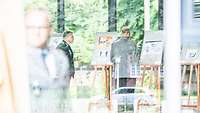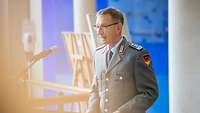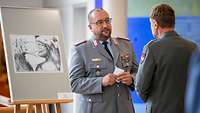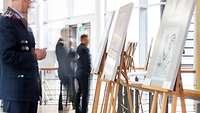Mockery with a pointed pen
Mockery with a pointed pen
- Date:
- Place:
- Hamburg
- Reading time:
- 3 MIN
For two months, 105 caricatures are adorning the Bundeswehr Command and Staff College – the perspective of other countries on reunification and unified Germany. In 1994, Chancellor Helmut Kohl opened the touring exhibition. Originating from the Haus der Geschichte in Bonn, it has visited many places and has now found its way to Hamburg Blankenese.
Almost 100 years ago, Kurt Tucholsky took up the subject of the political joke. In the Berliner Tageblatt newspaper, he concluded an article on the subject with the sentence “What may satire do? Everything.” The political joke, satire, caricatures – they are means of exaggeration or hyperbole used to get to the heart of a matter or a characteristic. The exhibition “Deutschlandbilder. Das vereinigte Deutschland in der Karikatur des Auslands” is on display until 15 October at the Manfred Wörner Centre of the Bundeswehr Command and Staff College in Hamburg. The exhibition is on loan from the Stiftung Haus der Geschichte der Bundesrepublik Deutschland (Museum of Contemporary German History Foundation), Bonn.
“The outside perspective may not always be friendly, especially, when it is pointed, but it opens up perspectives that are helpful, may well be necessary and should be taken seriously”,
said Colonel (GSGesetzliche Schutzaufgaben) Professor Matthias Rogg during his speech at the opening of the exhibition. It was also historian Rogg, Chairman of the Bundeswehr’s own think tank, the German Institute for Defence and Strategic Studies, who drew the reference to Tucholsky – because Tucholsky’s assessment has lost none of its relevance. The political joke sparks fierce controversy time and again.
The explosiveness of caricatures
The exhibition is dedicated to the question of how our neighbours or other countries perceived reunification and unified Germany – using only the stylistic means of caricature. It is a journey through images that Germany has conjured up abroad in the course of reunification – exaggerated, overdrawn, but to the point in many places. There is no question that caricatures can develop considerable explosive power, Rogg says, “just think of the Islamist terrorist attack on the offices of the satirical weekly newspaper Charlie Hebdo.” According to him, the political joke has a dimension that, in its amusement, poses an apparent danger to those in power to whom it is addressed. Satire points to weaknesses and draws them into the realm of the ridiculous. “Stable systems are able to and must endure this”, Rogg emphasised. “But if power is only poorly legitimised, then caricatures are dangerous for those in power.” At any rate, he says, caricatures often are like seismographs that indicate changes on the political weather map, even before the wind has changed.
Euphoria and Heyday
According to Rogg, “this exhibition reveals a lot about us, but at least as much about our neighbours.” It comprises 105 caricatures created by 57 caricaturists from 26 countries. During the first cycle, 66 pictures on easels will be on display at the Manfred Wörner Centre. The works show how people from other countries perceived us 30 years ago, how they assessed the problems of German Unity or even which fears and prejudices towards Germany were prevalent. The exhibition is divided into five sections. “Euphoria” and “Heyday” are currently on display. Halfway through, there will be an exchange – then visitors will be able to view caricatures on “Fourth Reich”, “Everyday life” and “Europe”.
A critical look at Germany – both from inside and from the outside – is always part of the teaching at the Bundeswehr’s major military training institution. “The exhibition is an enrichment for the international and national course participants at the Bundeswehr Command and Staff College. It is precisely in the right place here, because it gives you new perspectives on German history”, emphasised Colonel André Abed, Deputy Commandant and Director Strategic Affairs and Faculties.









